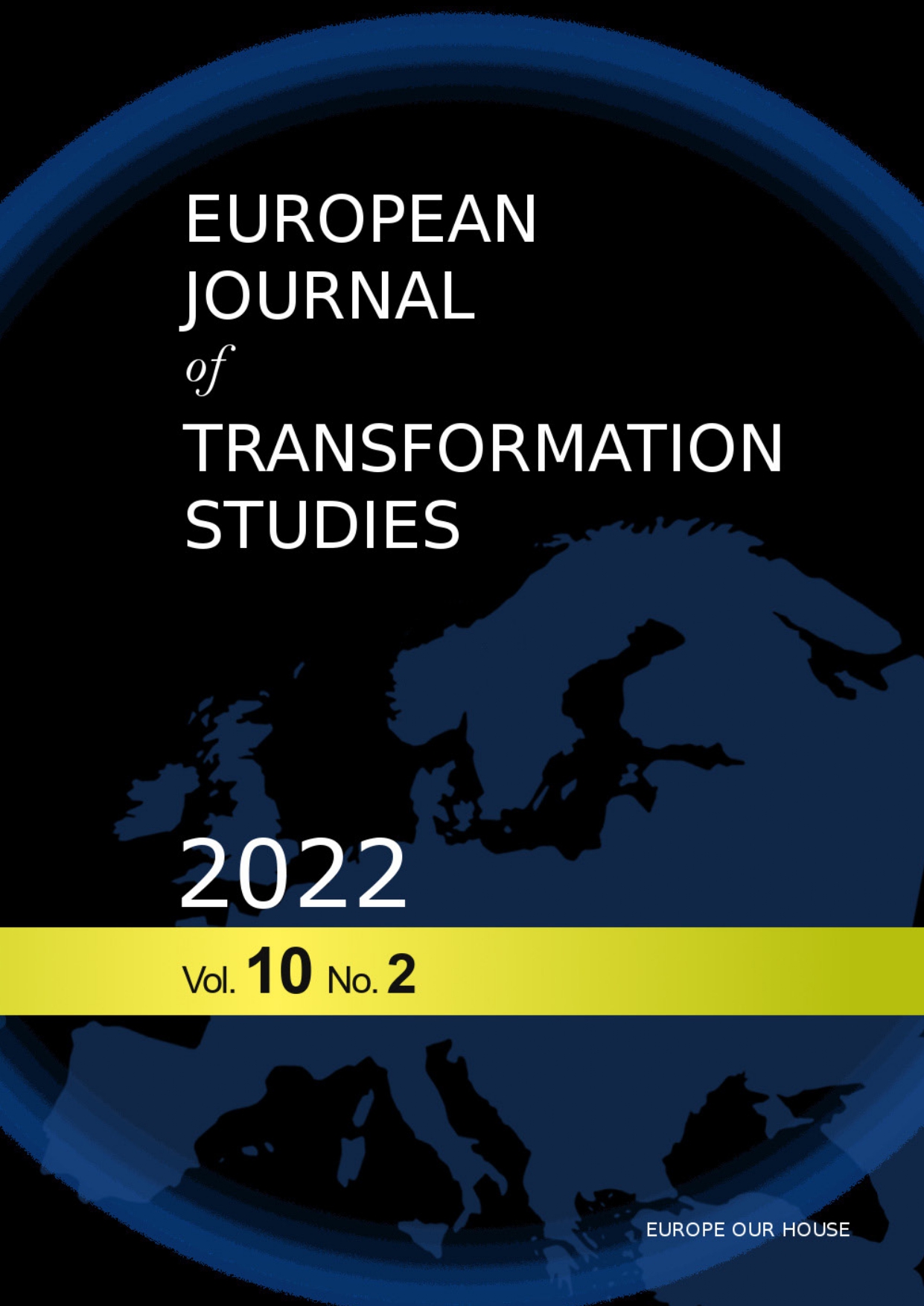Dynamics of aggressive discourse on Ukraine and the West in the Russian pro-government media in 2000-2022
Keywords:
Propaganda, Sentence Embedding, BERT, Content Analysis, Cluster AnalysisAbstract
The aim of this research is a build of a tool that helps to detect latent meanings of Russian propaganda messages. For this purpose, a new approach to building timeaware sentence embeddings was created, using the logic of the word2vec word embeddings model. An array of articles (754,372) from more than 50 Russian news websites for the years 2000–2022 was analyzed. In the dynamics of aggressive discourse towards the West and Ukraine, the key year is 2014 - the year of the beginning of the aggression against Ukraine. But at the same time, Russian propaganda positions it as a struggle for influence with the West, and this perfectly demonstrates the synchronicity of anti-Western and anti-Ukrainian propaganda.
Downloads
References
Alzahrani, S., Kim, N., Ozer, M., Ruston, S.W., Schlachter, J., Corman, S.R., (2018), Framing Shifts of the Ukraine Conflict in pro-Russian News Media. In: Thomson, R., Dancy, C., Hyder, A., Bisgin, H. (eds), Social, Cultural, and Behavioral Modeling. SBP-BRiMS 2018, Lecture Notes in Computer Science, vol. 10899, рр. 303-314, Springer, Cham, https://doi.org/10.1007/978-3-319-93372-6_34
Audinet, M., (2018), Diplomaties publiques concurrentielles dans la crise ukrainienne. Le cas de RT et Ukraine Today, In: Revue d’études comparatives Est-Ouest, vol. 2, no. 2, pp. 171-204, https://doi.org/10.3917/receo1.492.0171
Bamler, R., Mandt, S., (2017), Dynamic word embeddings. In: 34th International Conference on Machine Learning, ICML 2017, 1, pp. 607–621.
Carlo, V. D., Bianchi, F., Palmonari, M., (2019), Training temporal word embeddings with a compass. In: 33rd AAAI Conference on Artificial Intelligence, AAAI 2019, 31st Innovative Applications of Artificial Intelligence Conference, IAAI 2019 and the 9th AAAI Symposium on Educational Advances in Artificial Intelligence, EAAI 2019, pp. 6326–6334, http://arxiv.org/abs/1906.02376
Dajani, D., Gillespie, M., Crilley, Rh., (2021), Differentiated visibilities: RT Arabic’s narration of Russia’s role in the Syrian war. In: Media, War & Conflict, 14(4), pp. 437-458, https://doi.org/10.1177/1750635219889075
Denkovski, O., Trilling, D., (2020), Whose Fingerprint Does the News Show? Developing Machine Learning Classifiers for Automatically Identifying Russian State-Funded News in Serbia, In: International Journal of Communication, Vol. 14, pp. 4428-4452, https://ijoc.org/index.php/ijoc/article/view/13925/3193
Devlin, J., Chang, M. W., Lee, K., Toutanova, K., (2018), Bert: Pre-training of deep bidirectional transformers for language understanding. DOI: 10.48550/ARXIV.1810.04805, https://arxiv.org/abs/1810.04805
Gérard, C., Marotte, G., Salamatian, L., (2020), RT, Sputnik and the Yellow Vest Movement: Mapping Political Communities on Twitter, In: L’Espace politique, 40(1), https://doi.org/10.4000/espacepolitique.8092
Golovchenko, Y., (2020), Measuring the scope of pro-Kremlin disinformation on Twitter. In: Humanit Soc Sci Commun, 7, 176, https://doi.org/10.1057/s41599-020-00659-9
Hellman, J. S., Jones, G., Kaufmann, D., Schankerman, M., (2000), Measuring Governance, Corruption, and State Capture : How Firms and Bureaucrats Shape the Business Environment in Transition Economies. In: Policy Research Working Paper, No. 2312, World Bank, Washington, DC, https://openknowledge.worldbank.org/handle/10986/18832
Helmus, T., Bodine-Baron, E., Radin, A., Magnuson, M., Mendelsohn, J., Marcellino, W., Bega, A., Winkelman, Z. (2018), Russian Social Media Influence: Understanding Russian Propaganda in Eastern Europe, RAND Corporation, 148 p., https://doi.org/10.7249/RR2237
Kozlowski, A. C., Taddy, M., Evans, J. A., (2018), The geometry of culture: Analyzing meaning through word embeddings. In: American Sociological Review, no. 84, pp. 905–949, http://dx.doi.org/10.1177/0003122419877135, http://arxiv.org/abs/1803.09288
Kyrychenko, R., (2021), Typology of machine learning task in contemporary sociology. In: Sociological studios, no. 2(19), pp. 53–62, https://doi.org/10.29038/2306-3971-2021-02-41-48
Mikolov, T., Chen, K., Corrado, G., Dean, J., (2013), Efficient estimation of word representations in vector space. In: International Conference on Learning Representations, ICLR, http://ronan.collobert.com/senna/
Paul, C., Matthews, M., (2017), The Russian ”Firehose of Falsehood” Propaganda Model: Why It Might Work and Options to Counter It, RAND Corporation, DOI: 10.7249/pe198
Radnitz, S., (2022), Solidarity through Cynicism? The Influence of Russian Conspiracy Narratives Abroad. In: International Studies Quarterly, Vol. 66(2), https://doi.org/10.1093/isq/sqac012
Reimers, N., Gurevych, I., (2019), Sentence-bert: Sentence embeddings using siamese bertnetworks, CoRR abs/1908.10084, http://arxiv.org/abs/1908.10084
Reimers, N., Gurevych, I., (2020), Making monolingual sentence embeddings multilingual using knowledge distillation, arXiv.
Salnikova, S., (2014), Peculiarities of the normative regulation in Ukrainian and Belarusian societies. In: The dynamics of value and norm system and life chances: the experience of post-Soviet transformation in the Borderlands, YeGU, Vilnyus, рр. 90-193, рр. 329-352.
Salnikova, S., Kyrychenko, R., (2021), Sentiment analysis based on the BERT model: attitudes towards politicians using media data, In: International Conference on Social Science, Psychology and Legal Regulation (SPL2021): Advances in Social Science, Education and Humanities Research, Atlantis Press, Vol. 617, pp. 39–44, https://dx.doi.org/10.2991/assehr.k.211218.007
Wagnsson, Ch., Barzanje, C., (2021), A framework for analysing antagonistic narrative strategies: A Russian tale of Swedish decline. In: Media, War & Conflict, vol. 14(2), pp. 239-257, https://doi.org/10.1177/1750635219884343
Yao, Z., Sun, Y., Ding, W., Rao, N., Xiong, H., (2018), Dynamic word embeddings for evolving semantic discovery. In: WSDM 2018 - Proceedings of the 11th ACM International Conference on Web Search and Data Mining 2018-Febua, pp. 673–681, DOI: 10.1145/3159652.3159703
Zhang, H., (2019), Ucla ucla electronic theses and dissertations title dynamic word embedding for news analysis, https://escholarship.org/uc/item/9tp9g31f
INTERNET SOURCES
Angelov, D., (2020), Top2vec: Distributed representations of topics. arXiv. Available at: http://arxiv.org/abs/2008.09470 [Accessed September, 2022]
CoRR abs/1908.10084. Available at: http://arxiv.org/abs/1908.10084 [Accessed September, 2022]

 Academic Scientific Journals
Academic Scientific Journals



